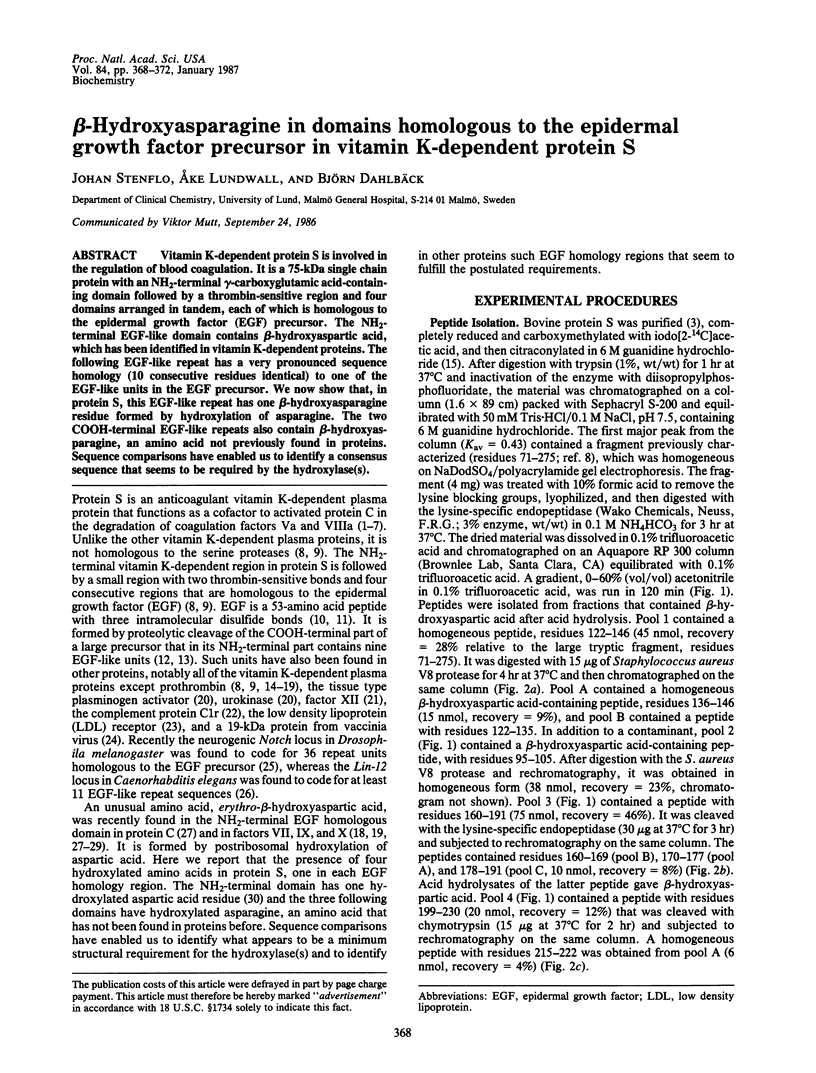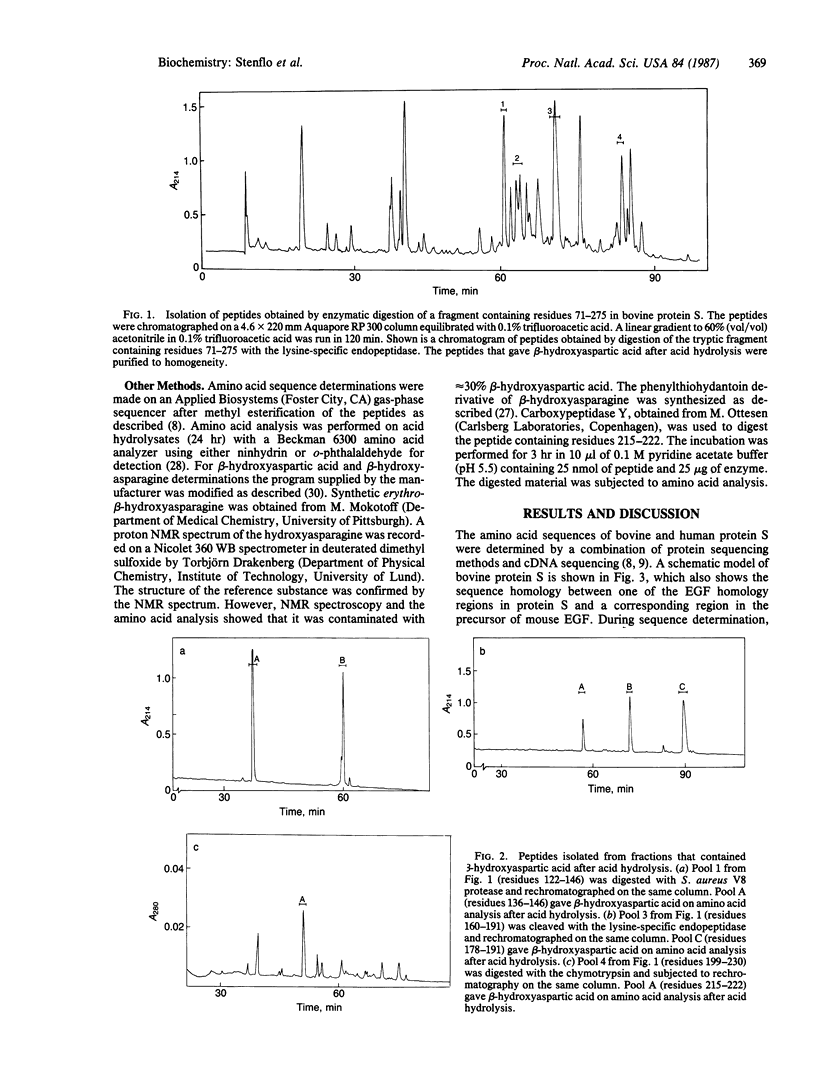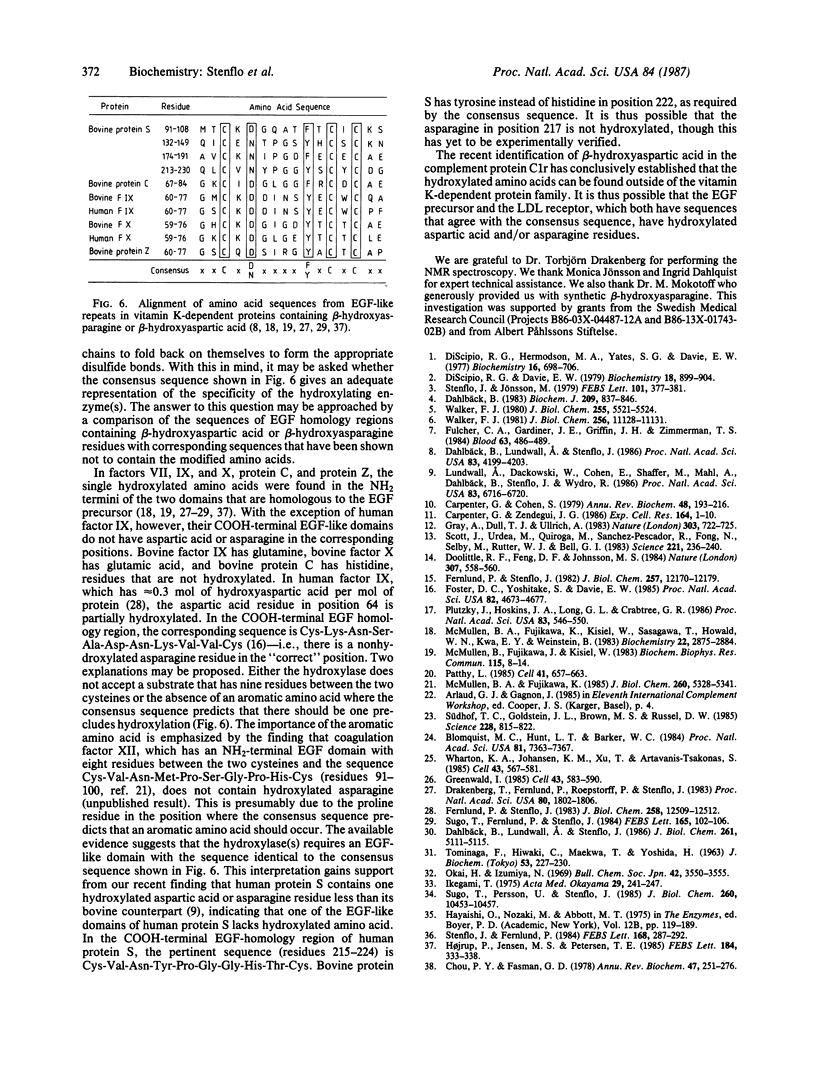Abstract
Vitamin K-dependent protein S is involved in the regulation of blood coagulation. It is a 75-kDa single chain protein with an NH2-terminal gamma-carboxyglutamic acid-containing domain followed by a thrombin-sensitive region and four domains arranged in tandem, each of which is homologous to the epidermal growth factor (EGF) precursor. The NH2-terminal EGF-like domain contains beta-hydroxyaspartic acid, which has been identified in vitamin K-dependent proteins. The following EGF-like repeat has a very pronounced sequence homology (10 consecutive residues identical) to one of the EGF-like units in the EGF precursor. We now show that, in protein S, this EGF-like repeat has one beta-hydroxyasparagine residue formed by hydroxylation of asparagine. The two COOH-terminal EGF-like repeats also contain beta-hydroxyasparagine, an amino acid not previously found in proteins. Sequence comparisons have enabled us to identify a consensus sequence that seems to be required by the hydroxylase(s).
Full text
PDF




Images in this article
Selected References
These references are in PubMed. This may not be the complete list of references from this article.
- Blomquist M. C., Hunt L. T., Barker W. C. Vaccinia virus 19-kilodalton protein: relationship to several mammalian proteins, including two growth factors. Proc Natl Acad Sci U S A. 1984 Dec;81(23):7363–7367. doi: 10.1073/pnas.81.23.7363. [DOI] [PMC free article] [PubMed] [Google Scholar]
- Carpenter G., Cohen S. Epidermal growth factor. Annu Rev Biochem. 1979;48:193–216. doi: 10.1146/annurev.bi.48.070179.001205. [DOI] [PubMed] [Google Scholar]
- Carpenter G., Zendegui J. G. Epidermal growth factor, its receptor, and related proteins. Exp Cell Res. 1986 May;164(1):1–10. doi: 10.1016/0014-4827(86)90449-0. [DOI] [PubMed] [Google Scholar]
- Chou P. Y., Fasman G. D. Empirical predictions of protein conformation. Annu Rev Biochem. 1978;47:251–276. doi: 10.1146/annurev.bi.47.070178.001343. [DOI] [PubMed] [Google Scholar]
- Dahlbäck B., Lundwall A., Stenflo J. Localization of thrombin cleavage sites in the amino-terminal region of bovine protein S. J Biol Chem. 1986 Apr 15;261(11):5111–5115. [PubMed] [Google Scholar]
- Dahlbäck B., Lundwall A., Stenflo J. Primary structure of bovine vitamin K-dependent protein S. Proc Natl Acad Sci U S A. 1986 Jun;83(12):4199–4203. doi: 10.1073/pnas.83.12.4199. [DOI] [PMC free article] [PubMed] [Google Scholar]
- Dahlbäck B. Purification of human vitamin K-dependent protein S and its limited proteolysis by thrombin. Biochem J. 1983 Mar 1;209(3):837–846. doi: 10.1042/bj2090837. [DOI] [PMC free article] [PubMed] [Google Scholar]
- Di Scipio R. G., Hermodson M. A., Yates S. G., Davie E. W. A comparison of human prothrombin, factor IX (Christmas factor), factor X (Stuart factor), and protein S. Biochemistry. 1977 Feb 22;16(4):698–706. doi: 10.1021/bi00623a022. [DOI] [PubMed] [Google Scholar]
- DiScipio R. G., Davie E. W. Characterization of protein S, a gamma-carboxyglutamic acid containing protein from bovine and human plasma. Biochemistry. 1979 Mar 6;18(5):899–904. doi: 10.1021/bi00572a026. [DOI] [PubMed] [Google Scholar]
- Doolittle R. F., Feng D. F., Johnson M. S. Computer-based characterization of epidermal growth factor precursor. Nature. 1984 Feb 9;307(5951):558–560. doi: 10.1038/307558a0. [DOI] [PubMed] [Google Scholar]
- Drakenberg T., Fernlund P., Roepstorff P., Stenflo J. beta-Hydroxyaspartic acid in vitamin K-dependent protein C. Proc Natl Acad Sci U S A. 1983 Apr;80(7):1802–1806. doi: 10.1073/pnas.80.7.1802. [DOI] [PMC free article] [PubMed] [Google Scholar]
- Fernlund P., Stenflo J. Amino acid sequence of the light chain of bovine protein C. J Biol Chem. 1982 Oct 25;257(20):12170–12179. [PubMed] [Google Scholar]
- Fernlund P., Stenflo J. Beta-hydroxyaspartic acid in vitamin K-dependent proteins. J Biol Chem. 1983 Oct 25;258(20):12509–12512. [PubMed] [Google Scholar]
- Foster D. C., Yoshitake S., Davie E. W. The nucleotide sequence of the gene for human protein C. Proc Natl Acad Sci U S A. 1985 Jul;82(14):4673–4677. doi: 10.1073/pnas.82.14.4673. [DOI] [PMC free article] [PubMed] [Google Scholar]
- Fulcher C. A., Gardiner J. E., Griffin J. H., Zimmerman T. S. Proteolytic inactivation of human factor VIII procoagulant protein by activated human protein C and its analogy with factor V. Blood. 1984 Feb;63(2):486–489. [PubMed] [Google Scholar]
- Gray A., Dull T. J., Ullrich A. Nucleotide sequence of epidermal growth factor cDNA predicts a 128,000-molecular weight protein precursor. Nature. 1983 Jun 23;303(5919):722–725. doi: 10.1038/303722a0. [DOI] [PubMed] [Google Scholar]
- Greenwald I. lin-12, a nematode homeotic gene, is homologous to a set of mammalian proteins that includes epidermal growth factor. Cell. 1985 Dec;43(3 Pt 2):583–590. doi: 10.1016/0092-8674(85)90230-2. [DOI] [PubMed] [Google Scholar]
- Højrup P., Jensen M. S., Petersen T. E. Amino acid sequence of bovine protein Z: a vitamin K-dependent serine protease homolog. FEBS Lett. 1985 May 20;184(2):333–338. doi: 10.1016/0014-5793(85)80633-5. [DOI] [PubMed] [Google Scholar]
- Ikegami T. Studies on the metabolism of beta-hydroxy- aspartic acid. Acta Med Okayama. 1975 Aug;29(4):241–247. [PubMed] [Google Scholar]
- Lundwall A., Dackowski W., Cohen E., Shaffer M., Mahr A., Dahlbäck B., Stenflo J., Wydro R. Isolation and sequence of the cDNA for human protein S, a regulator of blood coagulation. Proc Natl Acad Sci U S A. 1986 Sep;83(18):6716–6720. doi: 10.1073/pnas.83.18.6716. [DOI] [PMC free article] [PubMed] [Google Scholar]
- McMullen B. A., Fujikawa K. Amino acid sequence of the heavy chain of human alpha-factor XIIa (activated Hageman factor). J Biol Chem. 1985 May 10;260(9):5328–5341. [PubMed] [Google Scholar]
- McMullen B. A., Fujikawa K., Kisiel W., Sasagawa T., Howald W. N., Kwa E. Y., Weinstein B. Complete amino acid sequence of the light chain of human blood coagulation factor X: evidence for identification of residue 63 as beta-hydroxyaspartic acid. Biochemistry. 1983 Jun 7;22(12):2875–2884. doi: 10.1021/bi00281a016. [DOI] [PubMed] [Google Scholar]
- McMullen B. A., Fujikawa K., Kisiel W. The occurrence of beta-hydroxyaspartic acid in the vitamin K-dependent blood coagulation zymogens. Biochem Biophys Res Commun. 1983 Aug 30;115(1):8–14. doi: 10.1016/0006-291x(83)90961-0. [DOI] [PubMed] [Google Scholar]
- Patthy L. Evolution of the proteases of blood coagulation and fibrinolysis by assembly from modules. Cell. 1985 Jul;41(3):657–663. doi: 10.1016/s0092-8674(85)80046-5. [DOI] [PubMed] [Google Scholar]
- Plutzky J., Hoskins J. A., Long G. L., Crabtree G. R. Evolution and organization of the human protein C gene. Proc Natl Acad Sci U S A. 1986 Feb;83(3):546–550. doi: 10.1073/pnas.83.3.546. [DOI] [PMC free article] [PubMed] [Google Scholar]
- Scott J., Urdea M., Quiroga M., Sanchez-Pescador R., Fong N., Selby M., Rutter W. J., Bell G. I. Structure of a mouse submaxillary messenger RNA encoding epidermal growth factor and seven related proteins. Science. 1983 Jul 15;221(4607):236–240. doi: 10.1126/science.6602382. [DOI] [PubMed] [Google Scholar]
- Stenflo J., Fernlund P. Beta-hydroxyaspartic acid in vitamin K-dependent plasma proteins from scorbutic and warfarin-treated guinea pigs. FEBS Lett. 1984 Mar 26;168(2):287–292. doi: 10.1016/0014-5793(84)80264-1. [DOI] [PubMed] [Google Scholar]
- Stenflo J., Jönsson M. Protein S, a new vitamin K-dependent protein from bovine plasma. FEBS Lett. 1979 May 15;101(2):377–381. doi: 10.1016/0014-5793(79)81048-0. [DOI] [PubMed] [Google Scholar]
- Sugo T., Fernlund P., Stenflo J. erythro-beta-Hydroxyaspartic acid in bovine factor IX and factor X. FEBS Lett. 1984 Jan 2;165(1):102–106. doi: 10.1016/0014-5793(84)80023-x. [DOI] [PubMed] [Google Scholar]
- Sugo T., Persson U., Stenflo J. Protein C in bovine plasma after warfarin treatment. Purification, partial characterization, and beta-hydroxyaspartic acid content. J Biol Chem. 1985 Sep 5;260(19):10453–10457. [PubMed] [Google Scholar]
- Südhof T. C., Goldstein J. L., Brown M. S., Russell D. W. The LDL receptor gene: a mosaic of exons shared with different proteins. Science. 1985 May 17;228(4701):815–822. doi: 10.1126/science.2988123. [DOI] [PMC free article] [PubMed] [Google Scholar]
- TOMINAGA F., HIWAKI C., MAEKAWA T., YOSHIDA H. The occurrence of beta-hydroxyasparagine in normal human urine. J Biochem. 1963 Mar;53:227–230. doi: 10.1093/oxfordjournals.jbchem.a127683. [DOI] [PubMed] [Google Scholar]
- Walker F. J. Regulation of activated protein C by a new protein. A possible function for bovine protein S. J Biol Chem. 1980 Jun 25;255(12):5521–5524. [PubMed] [Google Scholar]
- Walker F. J. Regulation of activated protein C by protein S. The role of phospholipid in factor Va inactivation. J Biol Chem. 1981 Nov 10;256(21):11128–11131. [PubMed] [Google Scholar]
- Wharton K. A., Johansen K. M., Xu T., Artavanis-Tsakonas S. Nucleotide sequence from the neurogenic locus notch implies a gene product that shares homology with proteins containing EGF-like repeats. Cell. 1985 Dec;43(3 Pt 2):567–581. doi: 10.1016/0092-8674(85)90229-6. [DOI] [PubMed] [Google Scholar]



